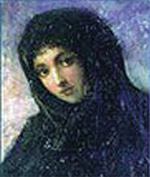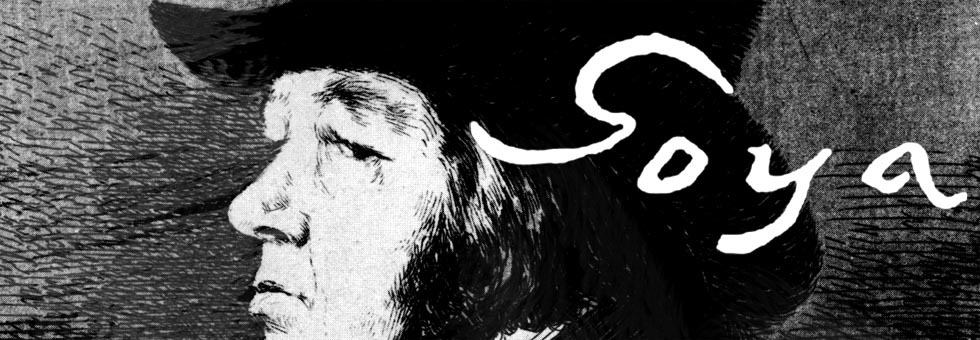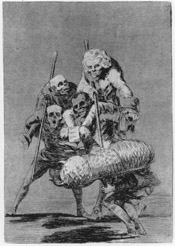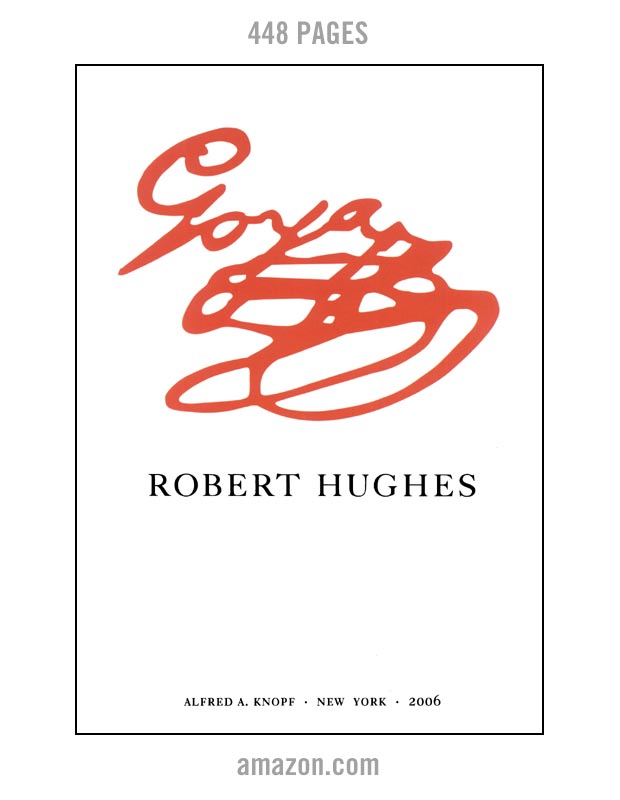Goya Archive 2003
Milkmaid of Bordeaux
Added information to the page on the painting.
The Zaentz/Forman Film on Goya
It's not exactly good news, but we have an update on the effort by the maker of the 1984 Mozart bio-film (Amadeus) to make one on Goya.
NEW DISPARATES PLATE 1
Added to the site
NEW CAPRICHOS PLATE 77
Added to the site
Is It A Goya?

The Prado nightmare: Velazquez versus Goya
Did Prado miss big buy, or is all the fuss just politics?By Roland Flamini, United Press International
December 6, 2003
Original
Story from the Washington Times
"...It's a Spanish museum, and the masters are the two giants of Spanish painting, each with his reputation recently refreshed.
It came close to happening. Indeed, say some, it did happen. And thereby hangs one of the year's most interesting art stories... the Spanish daily newspaper ABC revealed that the Prado apparently had passed up an opportunity to acquire "an extraordinary Goya" and had bought instead what the paper called "a minor Velazquez."
"The Divine Comedy: Francisco Goya, Buster Keaton, William Kentridge"
Until April 25, 2004
Vancouver Art Gallery
Vancouver, BC, CA Canada
Full story at Absoluteart.com
From the article: "The Vancouver Art Gallery will launch the new year with The Divine Comedy: Francisco Goya, Buster Keaton, William Kentridge, an exhibition that connects three artists from dramatically different historical periods and explores the relationship between comedy and violence, laughter and tears. From 18th century etchings to contemporary videos, this exhibition provides a timely look at how black comedy, absurdity and satire are used to express our relationship to a tumultuous world.
The Divine Comedy looks at aesthetics, politics and humour through Goya’s poignant and satirical late 18th century etchings, Keaton’s deadpan silent films from the 1920’s and Kentridge’s political contemporary drawings, prints, sculptures and videos."
The Artist Observed: Portraits and Self-Portraits"
2004
Exhibit at Cantor Arts Center, Stanford
"...included is a self-portrait by Francisco Jose de Goya. Completed in 1799, the etching depicts a hatted, collared figure staring off to the side of the print, quite unlike the usually extroverted artist."
Interview with Dr. Symmons on Goya
Dr. Sarah Symmons has a new book on Goya's personal letters coming out in April 2004.
We have a page on Dr. Symmons with more detail about this project here.
Be sure to check our page on Robert Hughes' Goya book, released November 2003 from Knopf.
Audio Interview with Hughes
Goya's "work posited a rather unstable world," says Robert Hughes in an interview about his new book. (Real audio file) The NY Times file is Here
Hidden Goya Self-Portrait in The Third of May?
October 2003
The
writer Siri Hustvedt discusses viewing the Goya painting El Tres de Mayo
and discovering a small self-portrait image in the shadowy lower left corner.
"I told myself that I had looked too long at this section of the painting and was seeing things the way children see images in shadows or clouds. And then, to my utter astonishment, I saw Goya's face staring out at me. It's a simple rendering - large eyes, flat nose and open mouth, but it includes the artist's signature leonine hair flowing out from around his jawline."
UK Guardian article here.
View the painting here.
David Gewanter's book of poetry "The Sleep of Reason" based on Goya's etching of the same name
October 12, 2003
"David Gewanter's intelligent, uneven new book of poems takes its name from an etching by Goya, ''The Sleep of Reason Produces Monsters,'' in which a sleeping artist's unfettered imagination gives birth to mad-eyed horrors. As you might expect, then, the poems here often involve violence, irrationality, ''the choke of fertility'' and other things that go bump in the night."
A
review of this book by
David Orr is at the NYTimes here.
THE SLEEP OF REASON
By David Gewanter.
University of Chicago, cloth, $28; paper, $14.
Goya etchings & Gusky photographs together for Dallas, Texas exhibit
"The 70 etchings and photographs, "Images of Human Tragedy in Black & White," are shown in tandem on the walls of the Meadows Museum on the Southern Methodist University campus. Each set is a potent, disturbing comment on man's inhumanity. Together, they are almost unbearable.
The earliest ones, etchings by Francisco de Goya, depict the atrocities of the Napoleonic Wars in Spain. The more recent set consists of photographs by Dr. Jeffrey Gusky capturing the legacy of the Nazis' extermination of the Polish Jews. Goya depicts acts of extreme brutality, Gusky only the shadowy remains of a civilization"
The
Meadows Museum, 5900 Bishop Blvd., Dallas
Through Jan. 4, 2004. Free Admission.
Information (214) 768-2516
Review
article by Gaile Robinson
Star-Telegram Art and Design Critic here.
Goya Disasters of War disfigured for modern art display
"No Shock, No Awe." By Perry McPartland
"Having received £500,000 from Saatchi for their piece, "Hell", the Chapman brothers purchased a complete set of Goya's "Disasters Of War" prints. Their new work, "The Rape Of Creativity" reveals them as having gone through the lot, changing the figures´ heads into clowns, nazis, rabbits and puppy dogs. As a piece it is symptomatic of the current floundering in the British art scene."
"No
Shock, No Awe," New York Arts Mag online article here.

Spanish
Art Exhibit in Louisiana
The Heart of Spain is a centerpiece of Central Louisiana’s celebration of the Louisiana Purchase Bicentennial and features work by such world renowned artists as El Greco, Murillo, Ribalta, and Goya. The collection is a magnificent cross-section of spiritually-themed paintings, tapestries, sculptures, jewelry and ancient symbols of faith that document one of the world’s oldest themes: man’s spiritual journey. "
Official
Web site was at heartofspain.com - site nolonger active (checked Sep 2019)
Alexandria Museum Website here
Alexandria "Town Talk" Review here
Times-Picayune Review here
GOYA NEWS ARCHIVE
Goya's the "Black Paintings"
La Quinta de Goya – Goya's home in Spain and location where he made the Black Paintings
Writings about the Black Paintings
De Salas on the Black Paintings
AMAZON
Goya The Terrible Sublime - Graphic Novel - (Spanish Edition) - Amazon
"From this headlong seizure of life we should not expect a calm and refined art, nor a reflective one. Yet Goya was more than a Nietzschean egoist riding roughshod over the world to assert his supermanhood. He was receptive to all shades of feeling, and it was his extreme sensitivity as well as his muscular temerity that actuated his assaults on the outrageous society of Spain." From Thomas Craven's essay on Goya from MEN OF ART (1931).
"...Loneliness has its limits, for Goya was not a prophet but a painter. If he had not been a painter his attitude to life would have found expression only in preaching or suicide." From Andre Malroux's essay in SATURN: AN ESSAY ON GOYA (1957).
"Goya is always a great artist, often a frightening one...light and shade play upon atrocious horrors." From Charles Baudelaire's essay on Goya from CURIOSITES ESTRANGERS (1842).
"[An] extraordinary mingling of hatred and compassion, despair and sardonic humour, realism and fantasy." From the foreword by Aldous Huxley to THE COMPLETE ETCHINGS OF GOYA (1962).
"His analysis in paint, chalk and ink of mass disaster and human frailty pointed to someone obsessed with the chaos of existence..." From the book on Goya by Sarah Symmons (1998).
"I cannot forgive you for admiring Goya...I find nothing in the least pleasing about his paintings or his etchings..." From a letter to (spanish) Duchess Colonna from the French writer Prosper Merimee (1869).
GOYA : Los Caprichos - Dover Edition - Amazon






